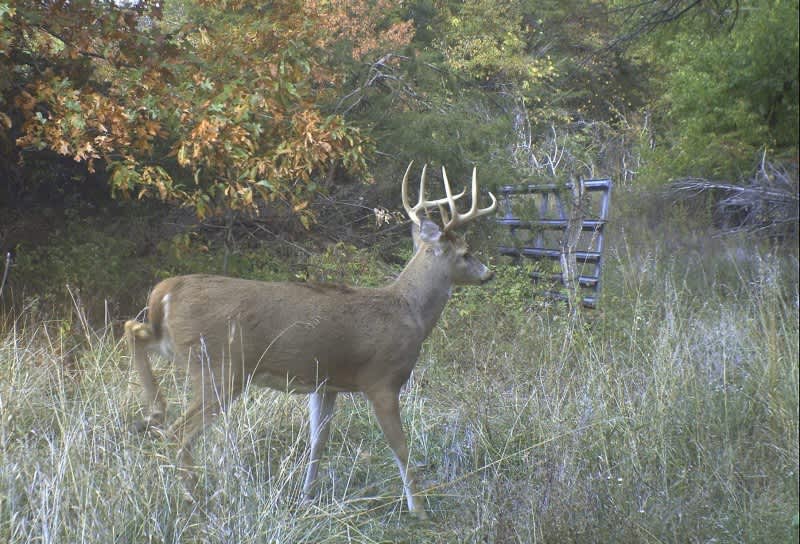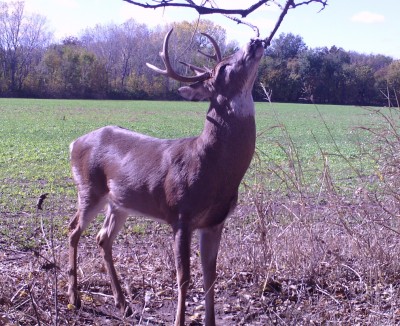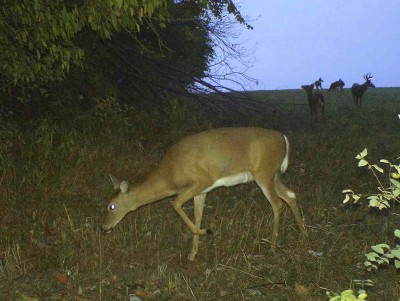Four Top Stand Sites for Late November Whitetail
Bernie Barringer 11.27.13

I walked to my stand that morning with a sense of urgency in my step. The rut was winding down. I had an unfilled archery tag in my back pocket and time was running out on the best time of the year to catch a mature buck unaware during daylight hours. I stopped to check a scrape near my stand and was encouraged to find fresh hoof prints in it.
Settling into my stand over the recently-freshened scrape, I relaxed as the woods came to life and daylight slowly flooded the landscape. I could just see around me and back into the woods when I heard footfalls coming through the leaves. With the leaves that had been on the trees when I first hunted this stand a month ago now on the ground, I could see for a fairly long distance. Sure enough, a buck was coming and it occurred to me that he had the same sense of urgency in his steps that I felt earlier.
He stopped about 80 yards downwind of the scrape and put his nose in the air. If he came to the scrape I would have a shot. If he continued on his way, I would be winded and the gig would be up. He clearly was checking the scrape from downwind. After spending a few tense moments testing the air as my heart pounded, he dropped his head and walked another 10 yards to where he hit my scent stream. That buck tucked his tail, lowered his chin and weaved out of there like a snake.

I learned a valuable lesson from that failed morning’s hunt. Bucks don’t have to actually visit a scrape to check it, and in fact rarely they do—except under the cover of darkness. But they do check scrapes regularly in the late season. I relate this example because it offers one key to finding a buck during the post-rut period. I’ll offer three more situations that will help you wrap your tag onto a late November buck.
Scrapes light-up again
During late October and the first week of November, scrapes can be a hub of activity for both does and bucks alike, but once the breeding begins in earnest, the action wanes and scrapes will have dry leaves lying in them for a couple weeks with little or no signs of action. But once the majority of does have been bred, the bucks are not ready to end the madness, so the scrapes once again become active. But the bucks are on the move and covering a lot of ground, so they do not visit every scrape, and in fact, like the buck I described above, a simple wind check from 75 to 100 yards downwind will suffice.
Place your stand downwind to take advantage of this opportunity. There may be a faint trail or there may not, but that’s where you need to be in order to be within range.
Bedding areas
Bucks know where the does bed and they will check those areas often. Once again, they are cruising and trying to cover a lot of ground, so they will check these bedding areas from downwind. Only if they smell something interesting will they move in to investigate further. In this situation, I like to set up on a well-used trail downwind of a bedding area and place a scent wick with doe-in-heat lure near my stand. It might be just the trigger that brings a cruising buck within range.

Feeding areas
Does and small bucks are run-down from the rigors of the rut and they need to replace fat reserves so they feed heavily and often. Bucks know where the food is and may spend some time filling their stomach in the same places. But once again they will spend time downwind of the food (which is often harvested crop fields such as soybeans or corn) and they will move right into the fields and bump the does around a little, checking for a late bloomer. I like a stand on the corner of the field where the bucks can enter quartering into the wind.
Another great stand location for these feeding areas is on a trail that often parallels the edge of a field 10 to 20 yards from the field proper. Bucks love to cruise these parallel trails checking out what is in the field before entering. You can set up a stand downwind of one of these trails and have a pretty good chance of seeing a buck that wouldn’t dare step out into the open during daylight.
Connecting areas
After nearly a month of rutting activity, trails may become defined between doe bedding areas. Does will not bed in the same area day after day, but will have a couple secondary bedding areas that that will use in bad weather, windy conditions, or when hunting pressure makes them uneasy in their preferred area. Bucks have been running from bedding area to bedding area for a couple weeks and chasing does all over these connecting trails. They are more visible now than they were before the rut. The best places to find them are along creeks and the tops of ridges. Remember to think high and think low to find these connecting trails. This is the one place that an all day sit has a high degree of productivity in the post rut.
So if you still have a tag in your pocket, do not despair. Find one of these opportunities and get yourself in position to bag a late November buck.
Follow Bernie’s bowhunting adventures on his blog, bowhuntingroad.com.

